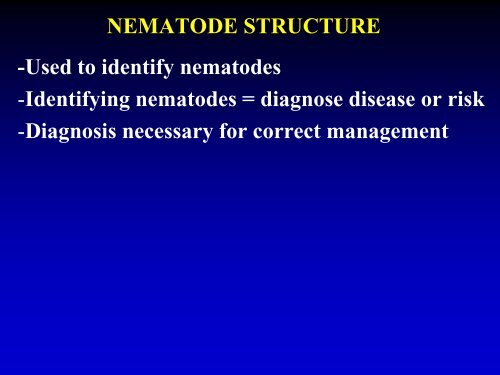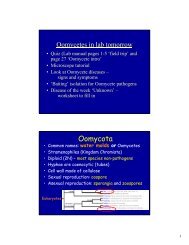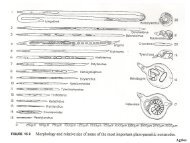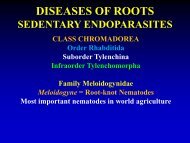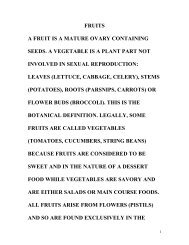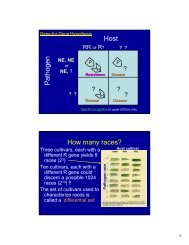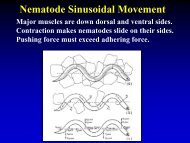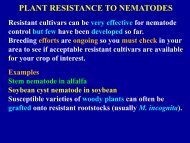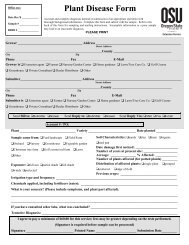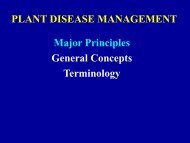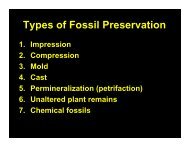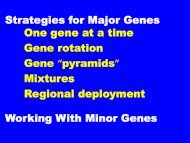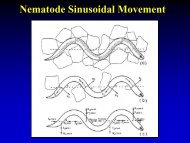NEMATODE STRUCTURE -Used to identify nematodes -Identifying ...
NEMATODE STRUCTURE -Used to identify nematodes -Identifying ...
NEMATODE STRUCTURE -Used to identify nematodes -Identifying ...
You also want an ePaper? Increase the reach of your titles
YUMPU automatically turns print PDFs into web optimized ePapers that Google loves.
<strong>NEMATODE</strong> <strong>STRUCTURE</strong>-<strong>Used</strong> <strong>to</strong> <strong>identify</strong> nema<strong>to</strong>des-<strong>Identifying</strong> nema<strong>to</strong>des = diagnose disease or risk-Diagnosis necessary for correct management
<strong>NEMATODE</strong> <strong>STRUCTURE</strong>-Invertebrate animals-Unsegmented roundworms “tube within a tube”Plectus parietinusHirschmann
<strong>NEMATODE</strong> <strong>STRUCTURE</strong>- Bilaterally symmetrical- Well developed digestive, reproductive,nervous systems- No circula<strong>to</strong>ry or respira<strong>to</strong>ry systemAccomplished by movement of fluids in body- Longitudinal muscles, but no circular muscles- Lengths range from 0.003 in. (marine sediments)<strong>to</strong> 27 feet (parasite in placenta of whales)- Plant-pathogenic nema<strong>to</strong>des are 0.01-0.22 in.
Kathy Merrifield
Nema<strong>to</strong>de MorphologyBody wall = Cuticle-Multilayered, nonliving, noncellular-Flexible exoskele<strong>to</strong>n, enters body openings-Semipermiable (O 2 , H 2 O, solutes)Hirshmann
Nema<strong>to</strong>de MorphologyCuticular StructuresFreckman,Baldwin-Many structures can be foundon the cuticle-Few are important <strong>to</strong> <strong>identify</strong>plant-pathogenic nema<strong>to</strong>des-Alae = expansions, projectionsCervical = neck regionLongitudinal = side of bodyCaudal = bursa, supplements
Cuticle = outside cover of nema<strong>to</strong>deTransverse markings = “striae”Areas between striae = “annules”Raised area along side of nema<strong>to</strong>de = “lateral field”with one lateral lineJ.D. Eisenback
No AnnulationCoarse AnnulationKathy Merrifield
Lateral field withthree lateral lines,separated byincisuresM.A. McClure
As nema<strong>to</strong>des grow they molt<strong>to</strong> shed their cuticle
StyletMedianBulbLipsProcorpusBursaSpicules in cloacaEggIntestineTestisLateralLinesLobe of esophagus glandoverlapping intestineOvaryIntestineVulvaPostuterine Sac(Present in species with 1 ovary)AnusTailBasic Nema<strong>to</strong>de Body Design
Nema<strong>to</strong>de MorphologyCephalic Region = Head, Lips etc.P = PapillaeI = innerO = outerC = cephalicA = AmphidsMouth“Tripartite”
Xiphinema americanumMouthPore-likeAmphid(taste)Lips (6 <strong>to</strong>tal)Papillae (<strong>to</strong>uch, taste)C.H. Hopper
ProbolaeLips may be replaced by probolae,hooks or teethAcrobeles sp.U. Zunke
Papillae may be elongated in<strong>to</strong> setaePapillae and setae are called sensillaDarwin Nema<strong>to</strong>de Project
Soil Dwelling Nema<strong>to</strong>desNon-Stylet BearersBacteriaAlgaeYeastsPreda<strong>to</strong>rsStylet BearersHigher PlantsFungiPreda<strong>to</strong>rs
Nema<strong>to</strong>de MorphologyCephalic Region = S<strong>to</strong>ma (Buccal Cavity)S<strong>to</strong>ma<strong>to</strong>stylet = derived from wall of s<strong>to</strong>ma
Rhabditis ?Bacterial FeederNarrow S<strong>to</strong>maU. Zunke
Panagrellus sp.Bacterial FeederWide S<strong>to</strong>maJ.D. Eisenback
Tylenchid 3-part S<strong>to</strong>ma<strong>to</strong>styletFormed from wall of the s<strong>to</strong>maRhabdions fuse <strong>to</strong> form hollow styletBasal Knobs = from telorhabdions1 dorsal & 2 subventralShaftmesorhabdionsmetarhabdionsBarbprorhabdionsJ.D. Eisenback
Tylenchida S<strong>to</strong>maCephalicFramework(cheilorhabdions)BarbShaftBasalKnobsHoplolaimus sp.Stylet Protrac<strong>to</strong>r MusclesPlant ParasiteJ.D. Eisenback
elonolaimus longicaudatusJ.D. Eisenback
Nema<strong>to</strong>de MorphologyCephalic Region = S<strong>to</strong>ma
Mononchus sp.Preda<strong>to</strong>rMural ToothU. Zunke
Ancyclos<strong>to</strong>macaninumDoghookworm
2-part Dorylamid Odon<strong>to</strong>styletDevelops as a sclerotized outgrowthin the esophagusBasal flanges = not “basal knobs”GuidingringStyletextensionStyletXiphinema indexU. Zunke
Dorylaimid Odon<strong>to</strong>styletwithout Basal FlangesLongidorusJ.D. Eisenback
Longidorus sp.Odon<strong>to</strong>styleGuidingringAmphidU. Zunke
Curved, Solid OnchiostyletDevelops from modified mural <strong>to</strong>othTrichodorus sp.
Solid, Curved Onchiostylet
Nema<strong>to</strong>de MorphologyEsophageal (Pharynx) Region
Nema<strong>to</strong>de Esophageal TypesKathy Merrifield
ESOPHAGEAL TYPES OF COMMON SOIL <strong>NEMATODE</strong>SNoStyletBacterialfeederS<strong>to</strong>maProcorpusBarbShaftBasal knobsS<strong>to</strong>ma<strong>to</strong>styletPlantpathogenProcorpusStyletStyletExtensionReplacementStyletOdon<strong>to</strong>styletPlantpathogenand virusvec<strong>to</strong>rMedian bulb(Metacorpus)ProcorpusIsthmusBasalRegionIntestineIsthmusBasalRegionIntestineBasalRegionRhabditida Tylenchida Dorylaimida
Meloidogyne hapla femaleTylenchid3-Part S<strong>to</strong>ma<strong>to</strong>styletBasal KnobsShaftBarbJ.D. Eisenback
3-part Tylenchid EsophagusIntestineProcorpusBasal regionslight overlapof intestineMetacorpus(median bulb)S<strong>to</strong>ma<strong>to</strong>styletDitylenchus dipsaciU. Zunke
Belonolaimus longicaudatusShaft ofs<strong>to</strong>ma<strong>to</strong>styletMetacorpusMedian BulbProcorpusBasal regionof esophagusR. S. Hussey
Meloidogyne incognita J2MetacorpusIntestineEsophageal glandoverlapping intestineProcorpusM.A. McClure
CriconemellaBasal regionof esophagusProcorpus fusedwith metacorpusJ.D. Eisenback
2-part Dorylaimid esophagus2-part Dorylaimid odon<strong>to</strong>styletOdon<strong>to</strong>style(stylet)Odon<strong>to</strong>phore(stylet extension)Lumen ofesophagusProcorpusof esophagusBasal regionof esophagusLongidorus sp.U. Zunke
Nema<strong>to</strong>de MorphologyCardia = Esophageal-Intestinal ValveAntiregurgitationFunction
Nema<strong>to</strong>de MorphologyIntestineIn posterior intestinenarrows <strong>to</strong> form a rectumHirschmann
Nema<strong>to</strong>de MorphologyIntestine
Nema<strong>to</strong>de MorphologyNervous Systemand Sense Organs
Nema<strong>to</strong>de Nervous SystemNerve Cords-Dorsal-Ventral-LateralNerves-Papillae-Amphids-PhasmidsGangliaNerve Ring= Circumpharyngealcommissure
Nerve Ring Stained for Cholinesterase ActivityEsophagusFree-living Nema<strong>to</strong>deJ.D. Eisenback
Nerve RingBasal regionof esophagusIntestine
Nema<strong>to</strong>de MorphologyNervous Systemand Sense OrgansPapillae = <strong>to</strong>uch, taste6 inner labial6 outer labial4 cephalic
Xiphinema americanumMouthPore-likeAmphid(taste)Lips (6 <strong>to</strong>tal)Papillae (<strong>to</strong>uch, taste)C.H. Hopper
Nema<strong>to</strong>de MorphologyNervous Systemand Sense OrgansAmphids = pouch with cilia and nerves-chemosensory-labial = on lips-sublabial = below lips on side of head-diverse in size and shape-no taxonomic significance-difficult <strong>to</strong> see in most plant parasites
Head of Meloidogyne cut open <strong>to</strong> reveal one oftwo amphids.
Stained amphid in Caenorhabditis elegansOliver Wagner
Nema<strong>to</strong>de MorphologyAmphids
Meloidogyne hapla J2Pore-like AmphidJ.D. Eisenback
Desmodora pilosaMarineNema<strong>to</strong>deUni-spiralAmphidW. D. Hope
DorylaimopsisMarine Nema<strong>to</strong>deSetaeMulti-spiralAmphidW. D. Hope
Nema<strong>to</strong>de MorphologyNervous Systemand Sense OrgansPhasmids = scutellum-on side of nema<strong>to</strong>de near tail-chemorecep<strong>to</strong>rs-nearly impossible <strong>to</strong> see
Scutellonema brachyurumPhasmid
ScutellonemabrachyurumPhasmid stainedwith hema<strong>to</strong>xylinM.A. McClure
Nema<strong>to</strong>de MorphologyReproductive System
Female Reproductive SystemOvaryGerminal zone = gamete formationGrowth zone = developing eggs, unfertilizedSpermatheca = s<strong>to</strong>res sperm, fertilizes eggs asthey go byOviduct = connects ovary and uterusUterus = may contain fertilized eggsVulva = may be sclerified, easier <strong>to</strong> see,position along length of body is diagnosticGrowth Zone
Female Reproductive SystemNumber of OvariesMonodelphic = one ovary (B, C)Didelphic = two ovaries (D, E, F)Position of OvariesAmphidelphic = opposed ovaries, oneanterior; one posterior <strong>to</strong> vulva (D, E)Prodelphic = ovary(s) anterior <strong>to</strong>vulva (B, F)Opisthodelphic = ovary(s) posterior<strong>to</strong> vulva (C)Post uterine sac = vestigial 2nd ovaryReflexed = ovaries folded (E, F)
Tylenchorhynchus sp. FemaleDidelphic, AmphidelphicVulvaVaginaUterusIntestineU. Zunke
Helicotylenchus sp.DidelphicAmphidelphicJ.D. Eisenback
Pratylenchus penetransMonodelphicProdelphicVulvaTheirry Vrain
Ditylenchus dipsaci femaleOvary stained with <strong>to</strong>luidine blueM.A. McClure
Structure of Nema<strong>to</strong>de EggTrue Shell (chitin)Vitelline MembraneVitellusProteinaceous CoatFormed after egg leavesgerminal zone
Male Reproductive SystemTestisGerminal zone = gamete formationGrowth zone = for development ofsperma<strong>to</strong>cytesSeminal vesicle = sperm s<strong>to</strong>rageCloaca = chamber where maledigestive and reproductivesystems joinSpicules = sclerotized copula<strong>to</strong>rystructureGubernaculum = sclerotized platethat supports spiculesBursa = Expansion of lateral field;forms flap that wraps aroundfemale during copulationMonorchic = one testisDiorchic = two testesReflexed = folded
Meloidogyne incognitaSpiculesOpening<strong>to</strong> CloacaM.A. McClure
Belonolaimus longicaudatusBursaGubernaculumSpiculesSpiculesBursaJ.D. Eisenbach
Copulating Free-living Nema<strong>to</strong>desFemaleVulvaMaleSpiculesJ.D. Eisenback
Nema<strong>to</strong>de MorphologyTails
Nema<strong>to</strong>de TailDistance from anus or cloaca<strong>to</strong> end of wormShape and length may bediagnostic or notTailU. Zunke
Rhabditis sp.J.D. Eisenback
Nema<strong>to</strong>de MorphologyEnd of Morphology Slides


